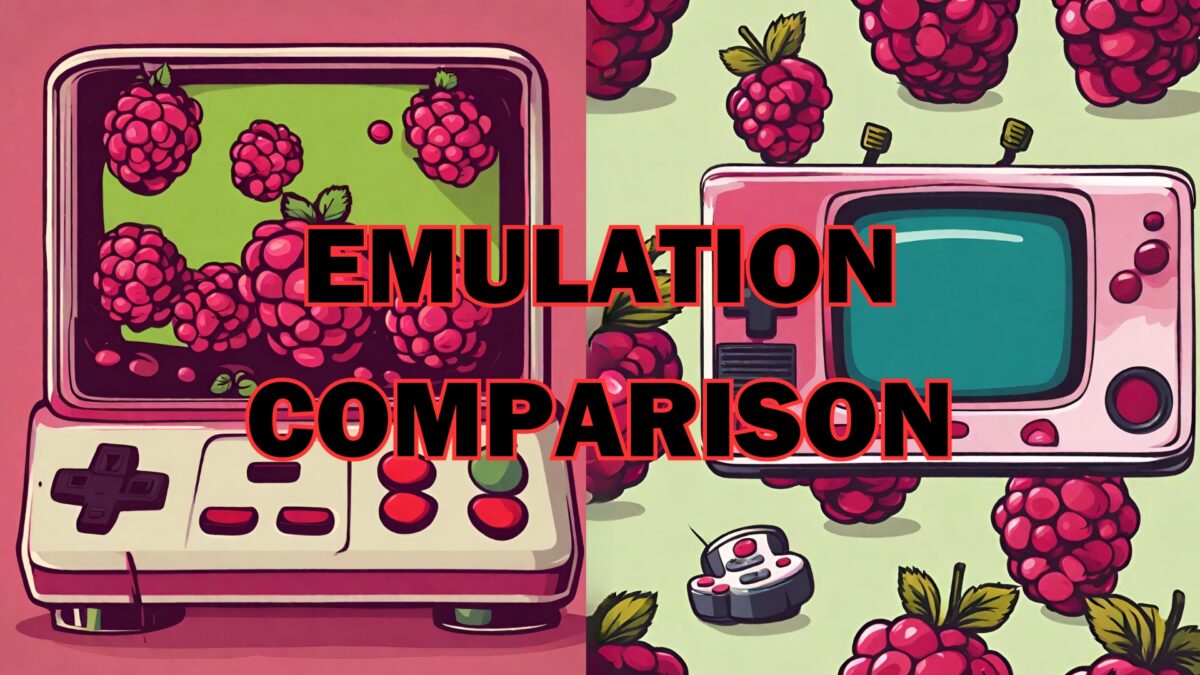Introduction:
The evolution of Raspberry Pi has seen it become an indispensable tool for tech aficionados and hobbyists. The newly unveiled Raspberry Pi 5, bursting with innovative features and a robust 2.4GHz quad-core 64-bit Arm Cortex-A76 CPU, is poised to outshine the Raspberry Pi 4, especially in running emulators. Let’s explore the revolutionary emulation capabilities of Raspberry Pi 5 and compare it with the Raspberry Pi 4 to illustrate the groundbreaking advancements made in this compact yet powerful device.
We have the largest collection of arcade cabinet options on the web for your Raspberry Pi 5.
The Raspberry Pi 5 Emulation Capabilities:
The Raspberry Pi 5, boasting its VideoCore VII GPU and dual 4Kp60 HDMI® display output, is a behemoth in emulation, providing unparalleled performance and game play experiences. It offers retro gaming enthusiasts an opportunity to experience seamless emulation of diverse gaming consoles, thus rekindling the nostalgic flame for classic games and establishing a new standard for emulation. Check out the official website.
Comparison Table:
| Feature | Raspberry Pi 4 | Raspberry Pi 5 |
|---|---|---|
| Processor | Quad-core Cortex-A72 @ 1.5GHz | 2.4GHz quad-core 64-bit Arm Cortex-A76 CPU |
| RAM | Up to 8GB LPDDR4-3200 | 4GB, 8GB |
| Connectivity | Gigabit Ethernet | Gigabit Ethernet, Dual-band 802.11ac Wi-Fi®, Bluetooth 5.0/BLE |
| USB Ports | 2 × USB 3.0, 2 × USB 2.0 | 2 × USB 3.0, 2 × USB 2.0 (5Gbps operation) |
| Graphics | OpenGL ES 3.0 graphics | VideoCore VII, OpenGL ES 3.1, Vulkan 1.2 |
| Display Output | Dual 4K | Dual 4Kp60 HDMI® |
| Additional Features | Standard 40-pin GPIO header | PCIe 2.0 x1, Real-time clock, Power button, High-speed microSD card interface |
Enhanced Performance:
The Raspberry Pi 5 brings forth a transformative emulation experience, powered by its 2.4GHz quad-core 64-bit Arm Cortex-A76 CPU and VideoCore VII GPU. This amalgamation of power and graphics capability ensures the emulation of more intricate and resource-intensive games, thus transcending the limits set by the Raspberry Pi 4. The substantial improvement in processing speed and the support for advanced graphics render a smoother and more immersive gaming encounter.
Seamless Connectivity:
The integrated dual-band 802.11ac Wi-Fi® and Bluetooth 5.0/BLE in Raspberry Pi 5 ensures impeccable connectivity, allowing users to effortlessly connect peripherals and accessories. This elevated level of connectivity, coupled with high-speed USB ports and Gigabit Ethernet, facilitates an enriched gaming interaction and a seamless setup of emulation stations.
Versatility and User Experience:
The Raspberry Pi 5 stands out with its versatile nature and intuitive interface, providing users with a diverse range of emulators. The refined user experience, coupled with advanced features like a real-time clock and a power button, solidifies its stance as a premium choice for emulation enthusiasts. The multifarious applications and the extensive support for various gaming platforms render it a formidable contender in the emulation domain.

Speculative Emulation Performance Comparison
| Emulator | Raspberry Pi 4 Rating | Raspberry Pi 5 Expected Rating |
|---|---|---|
| RetroArch | 7 | 10 |
| MAME | 6 | 9 |
| Dolphin | 3 | 8 |
| PCSX2 | 2 | 7 |
| PPSSPP | 5 | 9 |
| DesMuMe | 4 | 8 |
| ZSNES | 8 | 10 |
| ePSXe | 6 | 9 |
| Gens/GS | 7 | 10 |
| Project64 | 4 | 8 |
Explanation:
- RetroArch and ZSNES: Given that these are already running quite well on Raspberry Pi 4, we can expect close to optimal performance on Raspberry Pi 5 due to its upgraded hardware.
- MAME, PPSSPP, ePSXe, Gens/GS: These emulators should see substantial improvements with the increased CPU power and the more capable VideoCore VII GPU on the Raspberry Pi 5.
- Dolphin and PCSX2: These are more demanding emulators, and while the Raspberry Pi 4 struggles with them, Raspberry Pi 5 with its improved specifications is expected to handle them much better.
- DesMuMe and Project64: Moderate improvements are expected for these emulators owing to the better CPU and GPU on the Raspberry Pi 5.
Conclusion:
The advent of Raspberry Pi 5 marks a new era in emulation, underlined by its revolutionary specifications and cutting-edge features. It guarantees an unrivaled gaming experience, allowing users to delve deep into the retro gaming universe with unparalleled ease and sophistication. While the Raspberry Pi 4 has been a steadfast companion to emulation enthusiasts, the Raspberry Pi 5, with its sophisticated hardware and extensive connectivity options, is set to redefine the boundaries of emulation, providing a richer and more immersive retro gaming experience.
FAQ
Q1: What makes Raspberry Pi 5 suitable for emulation?
A1: The Raspberry Pi 5, with its powerful 2.4GHz quad-core 64-bit Arm Cortex-A76 CPU and VideoCore VII GPU, provides enhanced processing and graphical capabilities, making it suitable for a smoother and more responsive emulation experience.
Q2: Can the Raspberry Pi 5 emulate more advanced consoles compared to Raspberry Pi 4?
A2: Given its advanced specifications, the Raspberry Pi 5 is speculated to support a broader range of emulators for more advanced and recent consoles, allowing users to explore more diverse and demanding games compared to its predecessor.
Q3: Will Raspberry Pi 5 support RetroPie once it is released?
A3: While the expectation is high, the official support for RetroPie will depend on the development and optimization efforts by the RetroPie community. Typically, new Raspberry Pi models do get support, but there might be a waiting period.
Q4: How does the improved connectivity of Raspberry Pi 5 enhance the emulation experience?
A4: The improved connectivity options, including dual-band 802.11ac Wi-Fi® and Bluetooth 5.0, facilitate seamless interaction with controllers, peripherals, and networking, providing an enriched and versatile emulation experience.
Q5: Can Raspberry Pi 5 run MAME games like Killer Instinct efficiently?
A5: The speculation is that the enhanced hardware of Raspberry Pi 5 could potentially offer better performance on demanding MAME games like Killer Instinct, but real-world performance will depend on optimization and compatibility of the emulator software.
Q6: Will the Raspberry Pi 5 support dual displays for emulation?
A6: Yes, the Raspberry Pi 5 is expected to support dual 4Kp60 HDMI® display output, allowing users to run dual displays which can be particularly useful for multi-player or multi-game setups in emulation.
Q7: Does the speculated PCIe 2.0 x1 interface on Raspberry Pi 5 have any implications on emulation?
A7: The speculated PCIe 2.0 x1 interface could potentially allow users to connect high-speed peripherals, enhancing the overall flexibility and performance of the emulation setup, such as by using faster storage solutions.
Q8: Is the real-time clock in Raspberry Pi 5 beneficial for emulation?
A8: A real-time clock can be beneficial for emulation, especially for games and software that rely on real-time data, providing a more accurate and synchronized emulation experience.
Q9: How does OpenGL ES 3.1 and Vulkan 1.2 support in Raspberry Pi 5 impact emulation?
A9: The support for advanced graphical APIs like OpenGL ES 3.1 and Vulkan 1.2 can substantially enhance the graphical rendering and performance of emulators, allowing for better visuals and smoother gameplay.
Q10: Will Raspberry Pi 5 support multi-system emulators like RetroArch?
A10: While specific support will depend on the developers of multi-system emulators like RetroArch, the advanced specs of Raspberry Pi 5 make it a likely candidate for supporting such emulators, potentially offering enhanced performance and features compared to Raspberry Pi 4.


